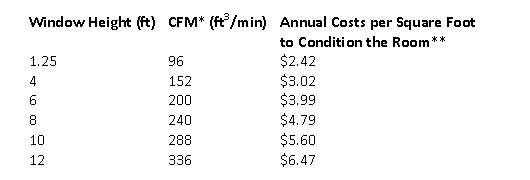While constructing an energy model of a North Carolina hospital, I became curious about the impact of window size on an individual room’s cooling load. I took the 80-square-foot room and varied the window height. The chosen “Solarban 70” had a U-value of 0.27 and a shading coefficient of 0.27. The room is also equipped with an overhang that projects 2.5 feet over the window at a height of 10 feet above the finished floor. The simulation was run assuming typical internal loads for lighting, people, and equipment for this office. The results were as follows:

Note: This window faces 36 degrees west of south.
*CFM of filtered 55°F air
**Costs are based on $0.80 per therm and $0.07 per kWh with a standard rate structure applied and includes lights, equipment, and heating and cooling loads
Most noteworthy was the time at which the peak cooling load occurs. One might assume it would occur during the hottest day of the year. And indeed this is true for the interior zones of the building, where the peaking cooling load occurs at 92 degrees Fahrenheit in July at 4:00 p.m. However, for a room with heavy glazing, the peak cooling load occurs in November at 3:00 p.m. At that time of year the outside air temperature is a comfortable 72 degrees Fahrenheit. This shows that the driving factor for the cooling load of this room is not conductive heat transfer through the glass and envelope, but rather solar radiation. Which makes sense considering the sun drifts southward in November and will shine more directly into the window.
Reductions in solar load would be felt were the window not facing both south and west. Students of passive solar design know that this is the most demanding quadrant for glass. Other possibilities would be to include a more robust overhang or some serious shades so as to better block direct sunlight. A further reduction in window size would also help.
It is exceedingly difficult to reach a compromise between a reduction in energy use and providing clients with a pleasant and open feel to their new space. As we continue to strive towards the 2030 initiative and other goals on truncated time tables we will need to re-train ourselves in energy effective envelope design. Instead of beginning with a concept of full-glass-façades, we will instead need to utilize a smart-size customized approach to ensure that each fenestration will not drive up the cooling load.